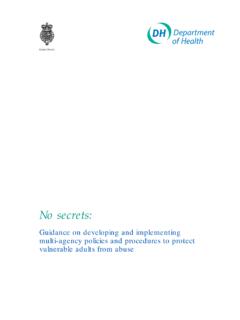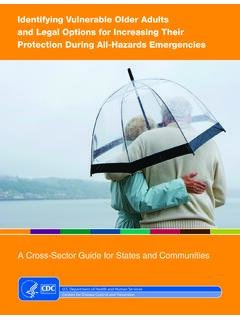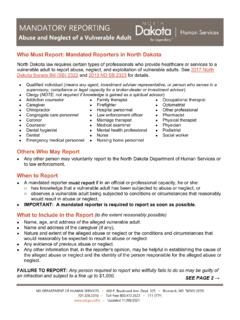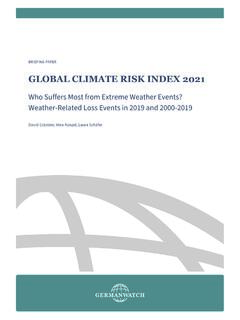Transcription of Vulnerable Groups and Inequalities - GOV.UK
1 March 2015 Vulnerable Groups and Inequalities Task and Finish group Report Children and Young People s Mental Health and Wellbeing Taskforce This report summarises proposals from the Vulnerable Groups and Inequalities Task and Finish Group of the Children and Young People s Mental Health and Wellbeing Taskforce and has informed the report Future in Mind: promoting, protecting and improving our children and young people s mental health and wellbeing. It is not a statement of Government policy. A full list of members and contributors is included at the end of the report. 2 Introduction This Task and Finish group brought together professionals drawn from numerous sectors and services with considerable expertise and experience of working with children, young people, and families with a range of different vulnerabilities. Following extensive discussions between group members and consultations with a wider constituency, agreement was reached on a vision for the future, the challenges needing to be overcome and proposals for change.
2 This Task and Finish group report addresses two key issues concerning children and young people with vulnerabilities. The first is that there are Groups of children and young people in our society with multiple difficulties and complex needs which significantly impede their access to, engagement with, and outcomes from services; this report therefore considers factors which contribute to this impediment and solutions for overcoming them. The second is that the majority of children and young people who need mental healthcare do have multiple vulnerabilities which often contribute to their reasons for needing mental health support; as such, whilst this report makes particular reference to Vulnerable Groups , it is framed by the overarching principle that many of the proposals made within this report can be applied across the whole system of child and adolescent mental health services.
3 The Vision 1. Children and young people with vulnerabilities that predispose them to mental health problems due to their biological or social history should be able to access and receive high quality support at an early enough stage to prevent entrenchment and escalation of existing problems. This means making changes to referral and access routes where these are known to exclude those with vulnerabilities. Services should take steps to increase access for Vulnerable individuals who might not reach the current threshold for support. 2. Children and young people with multiple difficulties and complex needs should be able to access and receive integrated support from a range of professionals across health, education, social care, youth justice, the police and the voluntary sector to ensure that their needs are met in a co-ordinated way.
4 3. Children, young people and their families who have vulnerabilities and complex needs should not have to fight for services. Services should take steps to increase access for Vulnerable individuals who might otherwise fail to be identified. The vision is to empower staff who are already working with Vulnerable children and young people by providing support from mental health practitioners when and where they are needed, provide co-ordinated services that make children feel safe, build resilience, and offer interventions and care that draw on the expertise and engagement of all the key agencies involved. 4. All the principles described in the CYP IAPT (Children and Young People s Improving Access to Psychological Therapies) programme should be actively implemented to ensure that all children and young people feel empowered, welcomed and able to engage in services.
5 This means that services need to be more accommodating of the range and complexity of the needs with which children and young people present. 3 Key challenges I have considerable experience of children and families caught up in the care system as a consequence of sexual abuse, sexual exploitation, learning disabilities, domestic violence, drug and alcohol abuse, neglect or offending behaviour. So many of these children and young people are damaged and suffer from any number of mental health but there are so few services now and those that do exist have very rigid referral basically there is nowhere for them to go. I remind you again that these depressed and unhappy children are our adults and parents of the future. These are the same people I know I will be assessing in 5 or 10 years time when their own children, too, are removed from their care. A psychologist who took part in the Taskforce engagement exercises , 5.
6 The challenges involved in meeting the mental health needs of children and young people with vulnerabilities are addressed below under the following headings: Eligibility and Access Engagement and Experience Systemic Issues 6. Eligibility and Access Greater exposure to adverse life events and other determinants of poor mental health render some children and young people more Vulnerable than others. These are children and young people who are impacted by multiple difficulties, each of which confer vulnerability to mental health problems. For those who accumulate multiple risks, their life chances may be weighted down, not by a single mental health difficulty, but by the accumulation of multiple biological and contextual factors conferring vulnerability, which taken individually may not meet the eligibility for services designed for children and young people who meet a diagnostic threshold.
7 It is frequently difficult for children and young people to meet the threshold for specialist mental health services. Currently, services are unlikely to make allowances for how these multiple difficulties interact with each other, and therefore assess the child or young person on only one aspect of the picture they present with. These children and young people are frequently precluded from accessing specialist services due to their sub-clinical levels of symptomatology. Given a narrow definition of mental health problems and rigidity of eligibility criteria, the presenting problems of children and young people with vulnerabilities may also lack clarity, so children and young people who have experienced significant adversity will only meet the criteria for existing services if the presenting mental health problem is clear, whereas it may not emerge or reach clinical significance for some time.
8 4 When CAMHS thresholds are so high many of these Vulnerable and sometimes labelled young people slip through the net. If funding was made available to develop specialist services and teams, with the resources and expertise to grow established relationships with some of the most Vulnerable Groups , a multi treatment model approach could be provided which in my experience has been most successful. A child and adolescent psychotherapist who took part in the Taskforce engagement exercises 7. Engagement and Experience The complexities of access to mental health services for children and young people with multiple vulnerabilities can lead to a marked delay before they become eligible for services, resulting in an escalation of their difficulties and increased distress while they wait for support. At this point, they frequently present with problems that have increased in severity and complexity.
9 Children and young people with certain vulnerabilities are not always willing to access conventional services they may experience the setting as alienating and punitive, or may have a lifestyle that is not conducive to meeting regular appointments. Appointments based in clinic settings are not the most suitable for Vulnerable Groups and their families, who may at least in the first instance until they are engaged with services be better served by outreach and home-based services. Vulnerable children and young people are likely to feel particularly disempowered and may have less support due to their social and family context. This means that simple and straightforward information and explanation about what to expect in the services will be particularly important along with person-centred and compassionate engagement by staff.
10 Children, young people and their families need to understand what to expect from services, what choices they have and how they can be involved in sharing decisions about their care. Services need to ensure that this information is written in an accessible way including Easy Read and that treatment programmes are constructed in such a way as to take into account any vulnerabilities which might act as obstacle to continued engagement. The existing evidence base, including NICE guidance, gives important pointers to what works effectively with some Vulnerable children and their families, including Looked After Children and children with conduct disorder. Other guidance is under development, including on attachment and child maltreatment. However for some Vulnerable children and young people whose problems are complex and may not fit a specific diagnosis, practitioners may be unclear how best to intervene.















